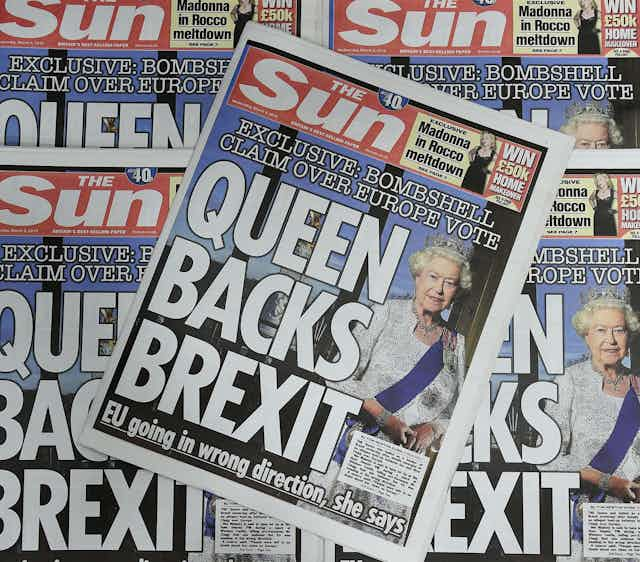The shadow of Brexit looms over the UK’s 2017 general election – as does the campaign that preceded the vote on June 23 2016. If this election campaign is anything like last year’s referendum campaign, the British public is in for a rough ride. The 2016 EU referendum campaign was the UK’s most intense, rancorous, negative and divisive national vote in decades. And mainstream media played a significant part in framing the campaign and setting its tone.
The tone and content of national media coverage of the EU referendum campaign is documented in a new study by the centre for the study of media communication and power at King’s College London. The study analyses all 14,779 articles published online about the referendum by 20 national news outlets during the ten-week 2016 campaign.
The study captures how the economic repercussions of Brexit, the impact of immigration and the importance of UK sovereignty featured in mainstream media. It also charts how the campaign came to be characterised by mutual accusations of scaremongering, discrimination and dishonesty.
Controlling the agenda
In the era of digital media an incumbent will struggle to control the political agenda throughout the campaign. Remain set the agenda for much of the first half of the Brexit campaign by focusing on the potential negative economic consequences of leaving the EU. There were 2,575 articles on this during the first five weeks.
Media was dominated by claims that households would be £4,300 worse off by 2030 outside the EU than within it and by then US president Barack Obama’s warning that the UK would go to the “back of the queue” for trade deals with the US if it left. There were similarly bleak predictions from the Bank of England, the Institute for Fiscal Studies, the International Monetary Fund, and the Organisation for Economic Co-operation and Development.
Yet – as analysis shows – after five weeks of campaigning, Leave leaders and sympathetic news outlets were able to shift the debate from the economy towards immigration. The average number of articles referring to immigration each week tripled over the course of the campaign. And they rose even faster once purdah began on May 27, when government and civil servants have to stop making any announcements.

Setting the agenda was not necessarily an asset. The authoritative figures and institutions that supported Remain and emphasised the economic risks of leaving were characterised – in the popular press and by Leave campaigners – as a self-interested elite. Remain, said the Leavers, represented an establishment that was pursuing a dishonest and unscrupulous strategy to scare people into voting Remain (547 articles referred to “the establishment”).
Economic warnings were framed by Leave campaigners and commentators as part of Remain’s “Project Fear”, a phrase referenced in more than 700 articles. This meant that well before people came to vote, the Leave campaign and sympathetic news outlets had managed to turn Remain’s ability to set the agenda into a liability.
Important discussions
Discussing immigration policy during a campaign is different from scapegoating migrants. Immigration was referred to more than 4,000 articles during the Brexit campaign. This was significantly more than were published on health, education or housing. Many of these articles discussed immigration policy and the general impact of immigration. Yet a high proportion were also hostile to migrants.
Migrants were blamed for everything from creating a housing crisis, to taking British benefits, overwhelming NHS maternity services, taking primary school places, bringing diseases to Britain and importing organised crime. Specific nationalities were singled out for particularly negative coverage – most notably Turks and Albanians, but also Poles and Romanians. The language used to described migration was one usually associated with natural disasters (flooding, swamped), animals or insects (flocking, stampeding, swarming) or foreign attack (invaders, storming, besieged).

If the Brexit campaign is anything to go by, issues whose importance will be apparent after the vote on June 8 will hardly be debated during the campaign. Policy issues that have become central to the process of Brexit following the referendum vote received far less attention during the campaign than the duopoly of economy and immigration. This included issues such as the future of the devolved nations – notably the Northern Irish border and Scottish independence, education and the future of universities, the environment and climate change. The same will almost certainly be true between now and the general election vote.
Lies, damned lies
Accusations of dishonesty undermine political debate and alienate voters. Whatever the truth of individual claims during the Brexit campaign, voters could be forgiven for distrusting both sides, given how frequently they accused one another of lying.
Iain Duncan Smith called George Osborne Pinocchio, Nigel Farage nicknamed the prime minister “dishonest Dave”, John Major called the Leave campaign “fundamentally dishonest”. Cameron himself said Leave was telling “total untruths to con the people”.
Almost every week of the campaign saw each side accusing the other of dishonesty (234 articles), of misleading the public (464 articles), or simply of lying (552 articles).

Rancour and vitriol characterised the EU referendum campaign. Overall, neither the campaign itself nor the media coverage of it were good advertisements for democratic politics. If there is one thing that all parties could learn from last year’s referendum campaign, it is that the bitterness of a negative and divisive campaign can have repercussions far beyond the vote itself.

